TAKING an iconic Aussie classic car and enhancing it while simultaneously retaining the essence of its style is a Herculean task. It requires a balanced eye, plenty of grey matter, huge amounts of talent and drive, and a big pair of stones.
First published in the January 2021 issue of Street Machine. Photos: Ben Hosking
Melbourne’s Dean Rickard knew this when he started the genre-shifting build of his HT Monaro back in 2016. It’s a car so finely detailed and thoroughly reengineered that it threatens to redefine what we consider a street car. The beautiful finish means it can slay at shows, but it is built to be driven long distances like a pro tourer, and yet it looks like a mildly modified classic.
“I had an HT Premier that I had done up, but it wasn’t quite as good as what I wanted,” Dean says. “I started looking through Street Machine for who was building the best cars and saw Down Town Kustoms’ FC ute and figured that was along the lines of what I wanted, which was to have an HT Monaro but to update it. I wanted to take the original style but modernise it.”
After deciding the cherry six-banger, three-on-the-tree HT Monaro was too clean to cut up, Dean found a tatty 307ci GTS in Albury that would make a perfect base for the build, and dragged it up to Taree for DTK to take a look at.
“When the car came in, one of the first things we did was to check the slop in the stock cast door hinges,” says Graeme. “I drew up the hinges and had them CNC-machined, with shoulder bolts and bronzed bushes so they look better, work smoother, the door opens a little wider, and they’re serviceable”
“The focus of the build was to make it 100 per cent HT Monaro but modernised and updated, without losing the flavour and style the HT Monaro has,” says Down Town boss Graeme Brewer. “Every single piece, no matter where or what it was, was removed and studied so we could modernise it, and that led to a huge amount of work.
“To start, we took all the panel skins off so the car could be blasted inside and out to get rid of every spec of dirt and rust, plus it makes it easier to do the tubs and chassis mods we needed to do. But many different pieces of the car rely on other seemingly inconsequential areas of the car.
“For example, when we set the brake booster on the firewall, we had to also set the pedal location, header and steering column clearance, plus then also ensure the under-dash panel sat nicely to hide all that work. Then you have to hide the ECU and loom, relays and the like, but also make it accessible to service as well. You really need to be able to do everything at once, so engine placement, steering, headers, column placement, pedals, and all that work needs to happen first because they impact the finished product massively.”
Complex custom builds are right in DTK’s wheelhouse, and in this instance they literally went above and beyond, taking Dean’s height into consideration and making appropriate alterations.
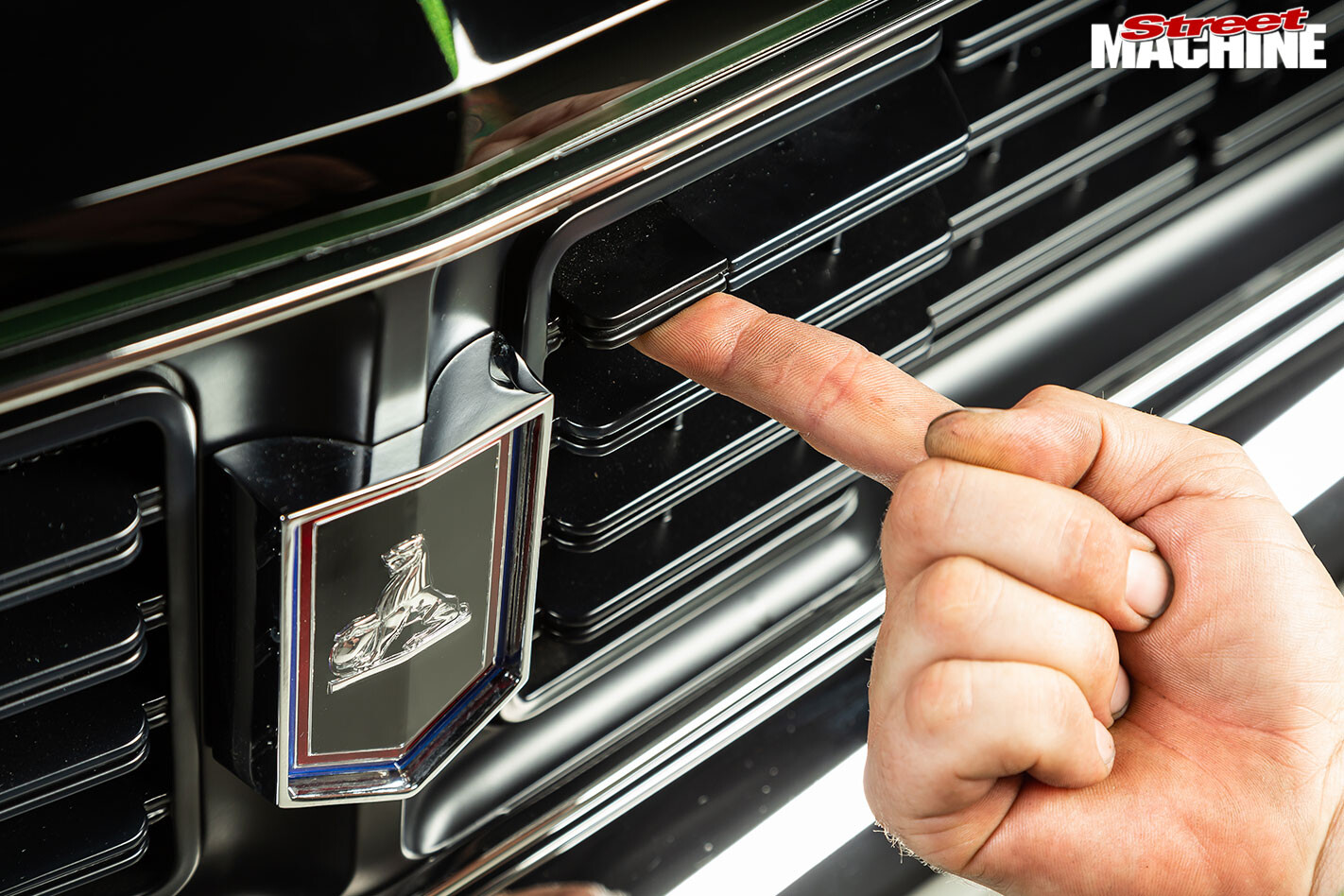
“We had to play with pedal ratios because Dean is so tall, so we had to customise the pedals to suit his height,” explains Graeme. “Then, all the roof braces were cut and modified to provide as much head room as possible, meaning a custom fibreglass inner skin had to be made, too.”
While it looks like an exceptionally well-finished stock HT Monaro shell, every single panel has been reworked to improve gaps and panel alignment, from the headlights right back to the tail-lights.
Because Dean wants to drive the HT, DTK fabbed up an alloy fuel tank to sit in between the chassis rails, which also holds a space-saver spare from a Nissan Pathfinder, with a toolkit from a VE Commodore sitting below that. “I told Graeme I wanted it to have a spare tyre and tools because I want to be able to use it, and if anything goes wrong I am not stranded,” Dean explains
“We’re friends with guys who worked in automotive design studios, so we get information from these guys about correcting panel alignment and style lines,” Graeme says. “Originally, the bonnets and boot lids were pressed and the metal got floppy, so they had to glue the bracing to stop the bonnet flexing. But the modern glues cause imperfections in the paint in sunlight. We fabricated these panels by hand so the metal stays tight and supports its own weight.
“We did so many little touches, like we lifted the bumper to get the gap to the grille and headlights better, and then lifted all the front sheet metal up to correct that gap underneath. We updated the bonnet latch to one off a modern Jimny, and then had to hide the secondary latch in a lateral bar of the grille. All the mounting points of the headlight buckets were changed, the wiper motor system was changed to a cable set-up so it works better, and the cowl vents were shaved. We moved all the lines around the tail-light buckets and we cut the bumpers, beaver panel and tail panel, all to make the gaps nicer and the lines better.”
The car’s impressive on-road manners come partly due to the custom full-chassis DTK designed, along with bespoke front and rear suspension architecture, replacing the floppy original Kingswood underpinnings. The HT has been built in conjunction with an engineer and it will be put through its paces after its show debut at MotorEx early in 2021
Underneath the HT is a computer-designed full chassis, hanging one of DTK’s own bespoke front ends featuring a custom K-frame, tube control arms, power steering racks and sway-bar, tied to an Ididit collapsible steering column. Ridetech coil-over suspension and Baer disc brakes round out the package at both ends, while the rear end hangs off a DTK rear clip and features their parallel four-link trailing arms and Watt’s link.
“Even though Monaro quarters are beautiful, we slightly changed their shape to fit the car better,” says Graeme. “Most people would want to shave the fuel filler, but I used a push-through filler and made a new door and hinge that is gapped perfectly and body-worked flat to the car. It also houses the CTek charger so you can get into the boot and jump-start the car or change the battery”
Under the bonnet is a stock 6.2-litre LS3 pumping an adequate and engineerable 435hp. With 10.75:1 comp, parts availability out the wazoo and OEM-level reliability, it is hard to beat, and ties back to the 307ci small-block Chev-powered origins of the HT, while a Tremec six-speed manual shifts way nicer than an old-school Muncie or Saginaw four-speed could ever hope to.
While it is a thing of beauty, the engine bay on Dean’s Monaro is also highly functional and has been designed to be a breeze to service. The 6.2-litre LS3 gulps atmosphere through a bespoke cold-air intake mounted behind one section of the grille. The secondary bonnet release is also operated through the grille, with one piece lifting up to open the security latching of the hand-made bonnet
“I think Dean’s car is indicative of our style at DTK, which is to build cars that drive,” says Graeme. “Dean’s car uses a lot of inventive textures, like the underbody spray, which was done so it almost looks like a flat paint instead of a normal underbody spray, just to elevate the finish and give it a warm tone.”
“There’s nothing like seeing these old cars on the road, being used,” says Dean. “The car turned out beyond my dreams. I never expected it to be this good, because Graeme has pushed beyond what I’d hoped for. The best thing about the build was that Graeme took charge from start to finish, so I just had to make some decisions and find the front seats. I’m really impressed with Graeme and the guys at DTK. I’ve never doubted them during the build; I have always felt comfortable with them and their decisions.”
“This car was an absolute pleasure to build,” says Graeme. “Dean was the best customer we’ve ever had. He’s so humble and he’s the nicest guy who is so appreciative of the work we do. Our whole team makes major decisions together and we can now stand back happy. There is no way in the world I could do this without my team of guys here at DTK.”
CABIN FEVER
WHEN it comes to HK-T-G Monaros, it seems impossible to do something new, so Graeme went high-tech for much of Dean’s two-door, and this is most visible in the cabin that Brent Parker Trimming painstakingly fitted out.
Dean chose the Mercedes SL500 seats for their integrated seatbelt system, as he didn’t want to see a visible seatbelt hanging down from the roof rail. “I looked everywhere for the SL500 seats, but all of them were water-damaged when I went to look at them,” he says. “Eventually I found these at a wrecker in Sydney”
“We did the entire interior in the metal stage right at the start of the build, because we didn’t want our trimmer to have to hand-sculpt pieces out of MDF or foam,” says G-man. “I got the original parts, drew them in CAD and then played with the design on the computer, doing things like adding speaker enclosures to the door cards, before we had the parts made out of modern materials and in a modern process.
“I had the door cards CNC-routed out of high-density foam to ensure there are no problems with buckling or water-soaking like with MDF. I’m pretty sure this is the first car in Australia where the interior has full pieces CNC-routed out of solid blocks of material, and it all snaps together with magnets.”
While that sounds simple in theory, this boundary-pushing technique meant plenty of late nights for Graeme, as he had to see what material he could use in a hard-wearing car designed to drive.
“There were countless hours testing which strength and size magnets to use, and what density foam and plastic to use, because I didn’t want to have problems with it going soft or coming apart. We then had a company that makes Olympic oars CNC-router the pieces for us.”
With 3D printing forming such an important part of work at DTK, Graeme used the modern technology to build one-off parts before they were painted or trimmed by Brent.
“I drew the original cluster and gauge pods in CAD, then 3D-printed the cluster,” he says. “The same for the centre console, which I modified to suit Dean’s car before we fabbed that piece in aluminium. We also 3D-printed the armrests, surrounds for the handbrake, start button and gear shifter, which we then got chromed.”
Despite all this high-tech malarky, the interior retains the classic feel of an old-school Monaro thanks to sympathetic nods to the original car, like the dials in the custom cluster. “The gauges are Dakota Digital units with warning lights and indicator lights, but they look like an analogue dial,” offers Graeme. “I found a Billet Specialties steering wheel that looked as close as possible to the original, then modified it to take the original-style Monaro centre button.
DEAN RICKARD
1969 HOLDEN HT MONARO GTS
Paint: Custom PPG green
ENGINE
Brand: GM LS3 6.2-litre
Induction: Stock
ECU: Stock Siemens E38
Heads: Stock 68cc L92-style rectangle-port
Camshaft: Stock 204/211 hydraulic-roller
Conrods: Stock powdered metal
Pistons: Stock hypereutectic aluminium
Crank: Stock nodular iron
Oil system: Stock
Fuel system: Stock
Cooling: Custom PWR radiator
Exhaust: Stock manifolds, modified
Ignition: Stock coils
TRANSMISSION
Gearbox: Tremec T56 Magnum six-speed manual
Clutch: Stock
Diff: Custom 9in
SUSPENSION & BRAKES
Front: Ridetech coil-over struts, DTK crossmember, DTK power steering rack, DTK tube arms, Ididit collapsible steering column, DTK sway-bar
Rear: Ridetech coil-over struts, DTK four-link & rear clip, DTK sway-bar, DTK Watt’s link
Brakes: Baer custom (f & r)
Master cylinder: Baer CNC-machined
WHEELS & TYRES
Rims: Schott; 18×8 (f), 19×10 (r)
Rubber: Pirelli P Zero; 225/40r18 (f), 255/40r19 (r)
THANKS
Graeme and the DTK guys; Brent Parker for the trimming; Peter Lamb from Melomotive; Jarrod from Concours Moulding & Polishing; PPG for their work developing the colour; Carl Donnellan for his help with painting
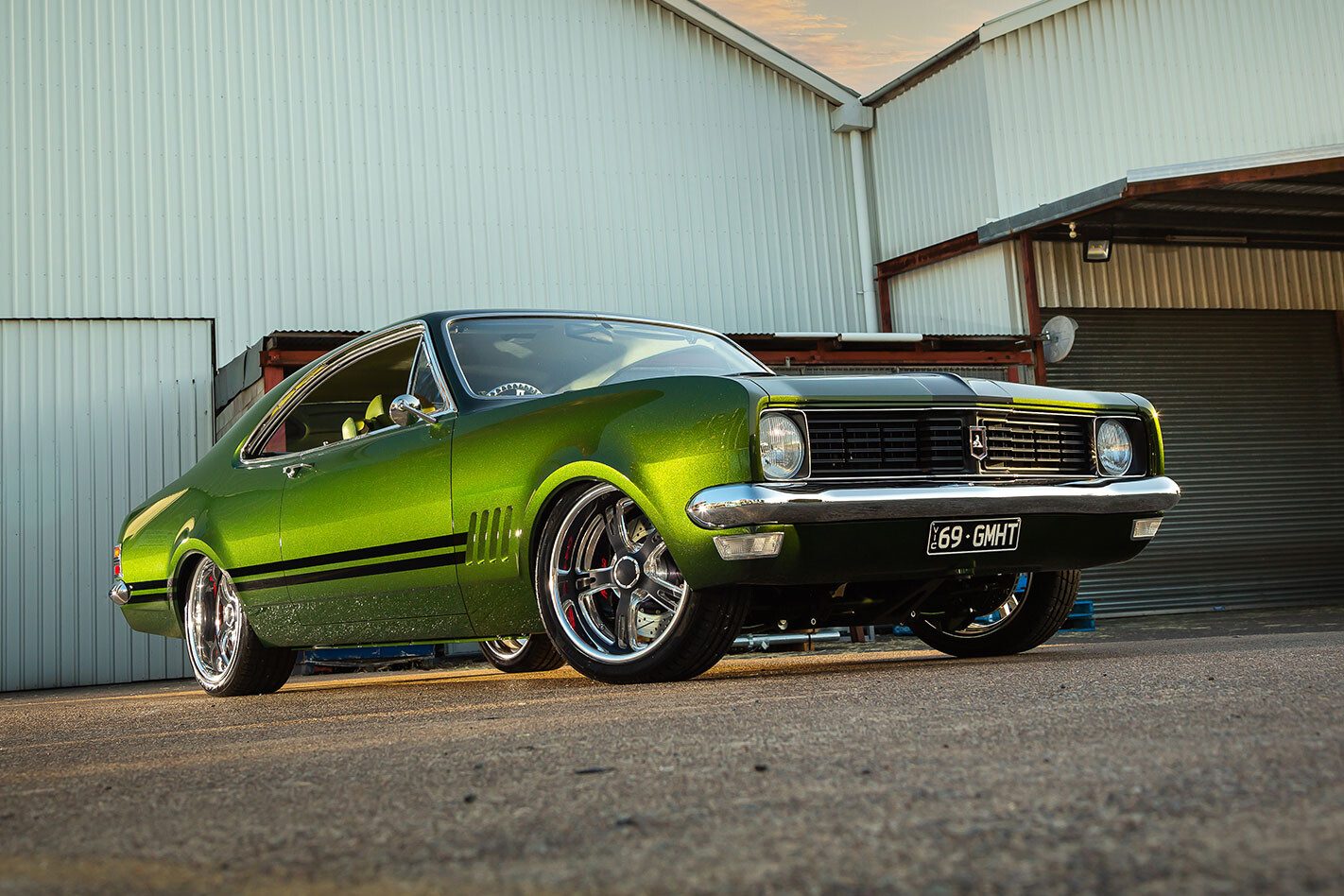
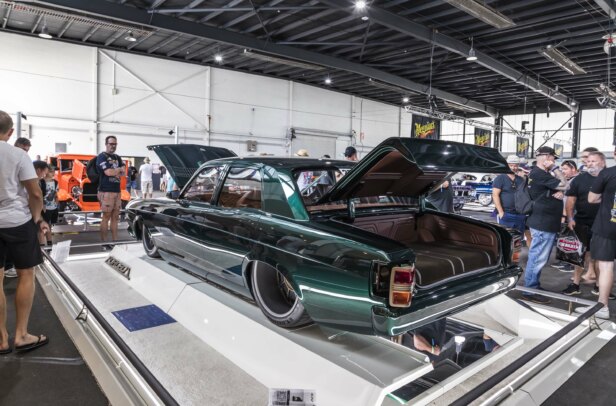
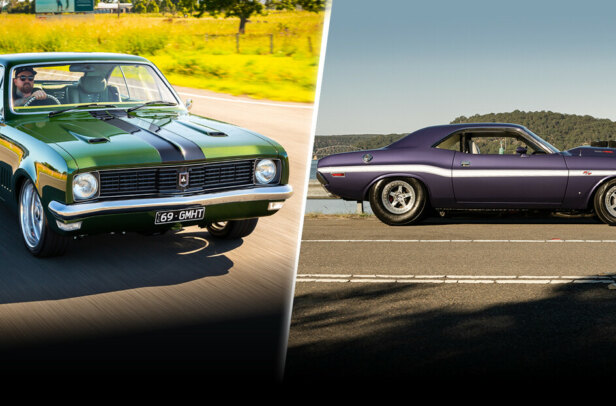
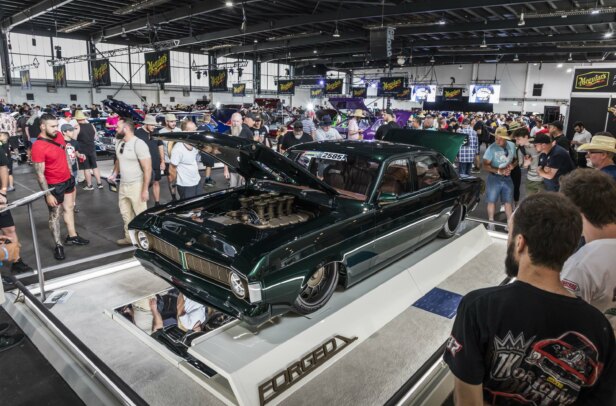
Comments